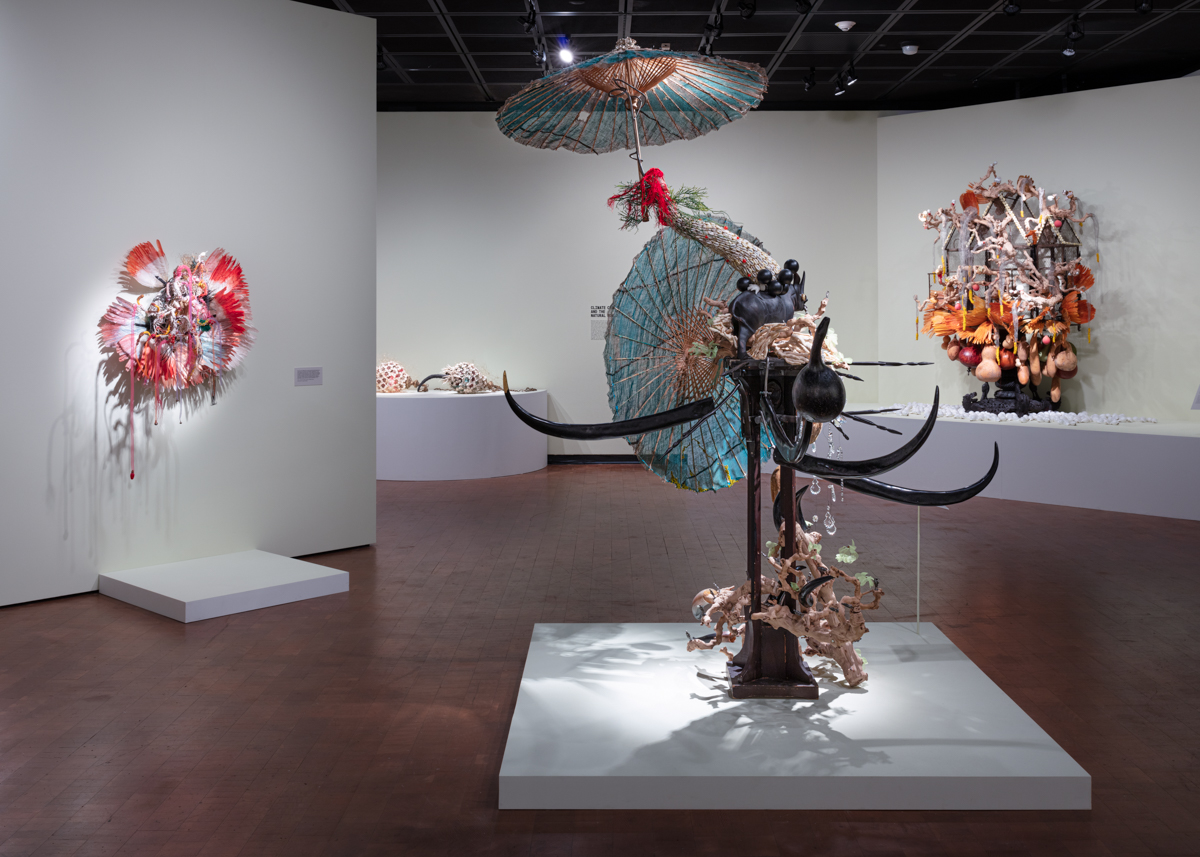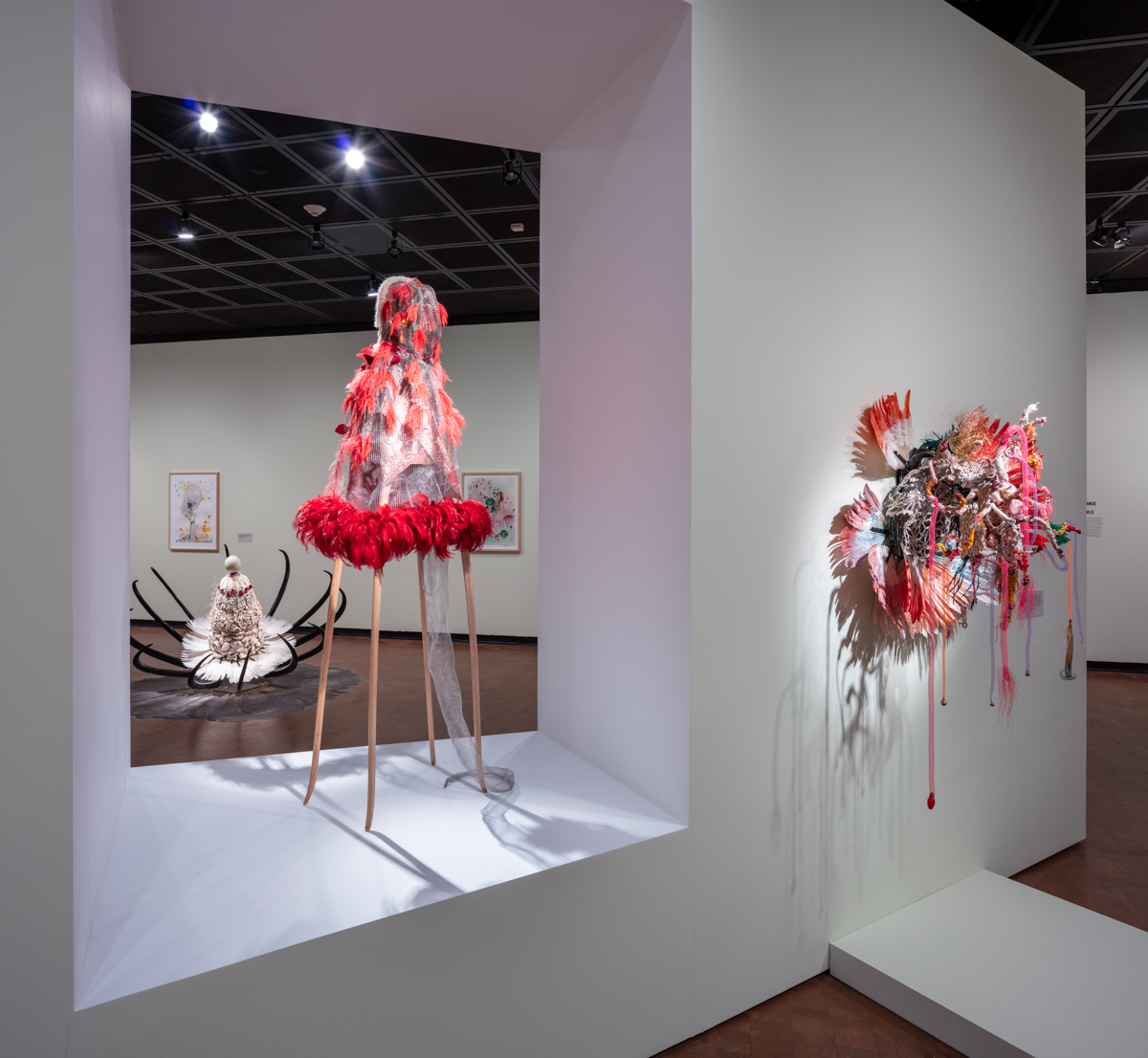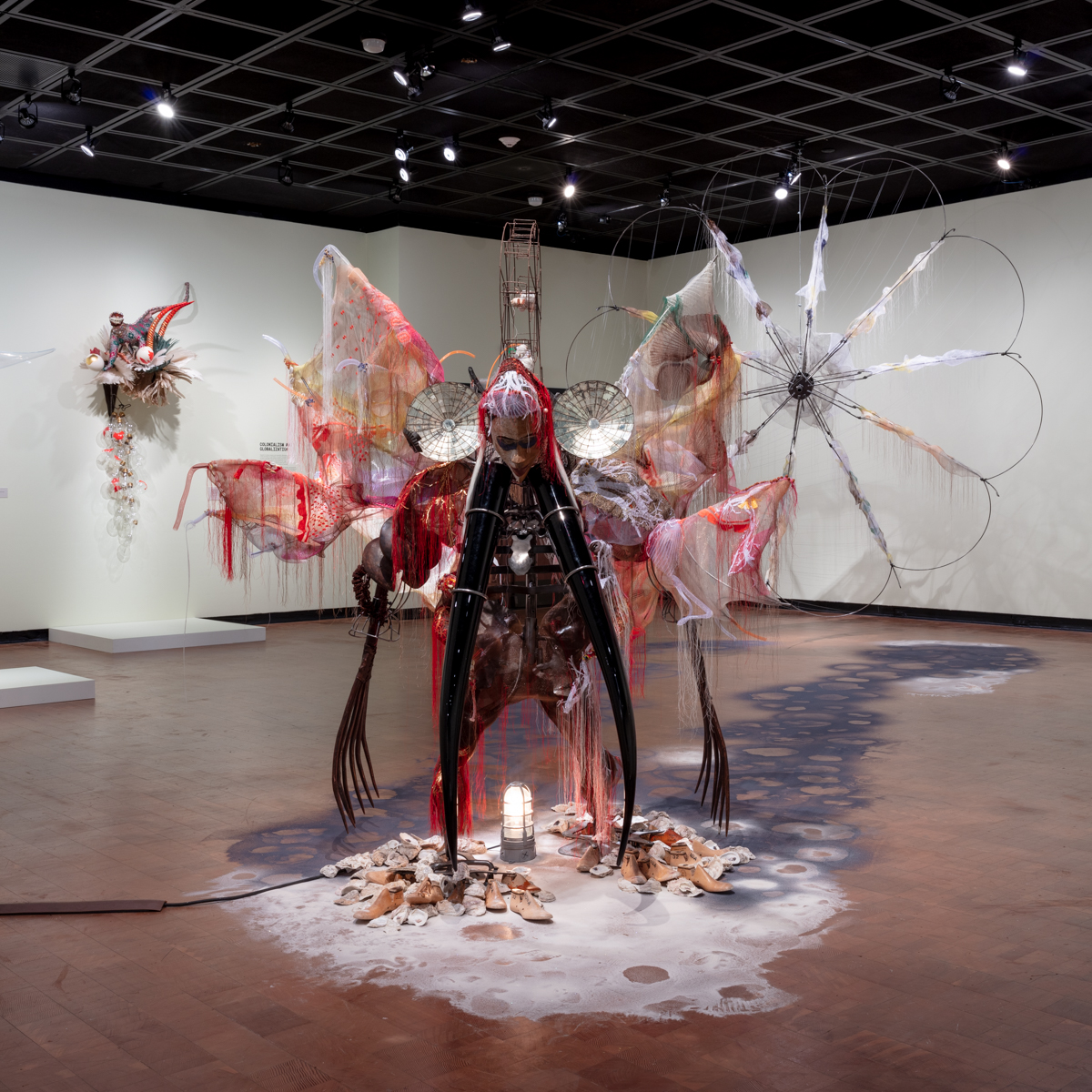Rina Banerjee’s assemblage-based sculptural practice reflects on the role that consumerism and “soft” imperialism have had in perpetuating colonialist mindsets within and beyond the Global South. She spoke with X-TRA editor Anuradha Vikram on the opening of her solo exhibition Make Me a Summary of the World at the Fowler Museum at UCLA, co-organized by the Pennsylvania Academy of the Fine Arts and the San Jose Museum of Art.

Rina Banerjee, Her captivity was once someone’s treasure and even pleasure but she blew and flew away took root which grew, we knew this was like no other feather, a third kind of bird that perched on vine intertwined was neither native nor her queens daughters, a peculiar other, 2011. Anglo-Indian pedestal from 1860, Victorian birdcage, shells, feathers, gourds, grape vines, coral, fractured Charlotte doll heads, steel knitted mesh with glass beads, Kenyan tourist sculptures, apple gourds, 7 x 7 x 6 ft. Installation view, Make Me a Summary of the World, The Fowler Museum, Los Angeles, December 8, 2019–May 31, 2020. © Rina Banerjee. Courtesy of Cornell Fine Arts Museum, purchased with funds from the Michel Roux Acquisitions Fund, 2016.20. Photo: Fredrik Nilsen.
ANURADHA VIKRAM: You’ve said you seek to create a different kind of awareness in viewers of your work. What kind of awareness do you mean?
RINA BANERJEE: An artist is often inviting the audience to ask themselves, “What are you seeing? What are you feeling? What are you thinking? What is the language and the perspective you’re coming from allowing you to see? What are you noticing that the particular history you have, the experience you have, doesn’t allow you to see?” Art is a very complex experience, and that’s what a physical encounter with the work can provide for you that seeing the work on the internet cannot.
AV: You have made armatures and support systems into a form within this work. We see a lot of the built armatures or the steel foundations of the sculptures, and they function as parts of the sculpture, but they also function as its supports. That seems like a new direction in the work.
RB: You could be right. Some of these pieces don’t have any armature and I continue to like doing that. I’m using everything from furniture to conventional pedestals, like in Make me a summary of the world… (2014),1 where there’s a plinth and atop it a piece of furniture that is used as a pedestal. The birdcage in this work, Her captivity… (2011),2 allows me to use it as an armature and, at the same time, it’s present and it’s clear as a birdcage. I do like to show the skeleton. Some of what I do is about not relying on the structure, how I do this balancing act. I find it a lot of fun because it is a conversation about the center of gravity, how certain materials can withstand imbalance and balance, the durability, the strength of the materials.
AV: I’ve heard you refer to a collecting impulse that goes along with colonialism in the Euro-American imagination, when discussing Her captivity. Can you explain how your work responds to that impulse?
RB: The collecting impulse is so significant in our economy, and has been for a long time, before colonialism. It’s a very visible human impulse. It requires so much responsibility and having the means to take care of so many things. The value of space now defines luxury. It’s very different from the colonial period, represented by large spaces with lots of stuff. The idea of minimalism requires placing a certain value on empty ownership, and that empties meaning itself. That kind of filtering—taking things out—requires taking out people. You know, we don’t think of the heavens as being crowded. We do think of hell as being crowded.

Rina Banerjee, Make me a summary of the world! She was his guide and had traveled on camel, rhino, elephant and kangaroo, dedicated to dried plants, glass houses—for medical study, vegetable sexuality, self-pollination, fertilization her reach pierced the woods country by country, 2014. Wood rhino, Chinese umbrellas, sea sponges, linen, beads, pewter soldiers, grape vines, glass chandelier drops, acrylic horns, wire, nylon and bead flowers, 7 x 4 ft. Installation view, Make Me a Summary of the World, The Fowler Museum, Los Angeles, December 8, 2019–May 31, 2020. © Rina Banerjee. Courtesy of the artist and Galerie Nathalie Obadia, Paris/Brussels. Photo: Fredrik Nilsen.
Pleasure in emptiness has an impact on the way we see nature as a little too full. What is paradise in its fullness with all the variety of things, species, biodiversity? What we once considered a bounty is no longer admired. Decluttering makes you think you’ve achieved something. That’s a very European, American sensibility. You can’t go to my grandfather’s house, who had only a hammock and a cot to sit on as furniture, and talk to him about this.
AV: You’re describing how our use of space has changed. We’ve gone from associating wealth with the possession of large quantities of objects to this new idea, as per Marie Kondo, that having space for potential new objects is, in itself, true wealth. How does your work engage with those ideas of consumption as they relate to the experience of art and its status as a luxury object?
RB: The idea of luxury objects is exclusive to a small community of people. You have to be constantly aware of that. Artists are designing a cultural currency that doesn’t agree with a large part of the world.
The materials I choose are not conventional. This is work that saddles both sides, in some sense, because to be in the middle means that neither side agrees that you should even exist. That’s what diasporic art can do, because we don’t really exist according to the conventional conversation.
AV: You spoke a little bit about diaspora in the context of the work titled Viola, from New Orleans-ah… (2017),3 and uniting these two diasporas, the South Asian and the African, which so often overlap in history and in geography but are often separated in discourse.
RB: There are many neighbors to India that interest me because we have similarities in the way we are drawn to certain textiles and methods, whether it be block printing, or dyeing, or using seashells in the work. To whose advantage is it that these things remain in separate dialogues and are never connected? So often when we talk about any culture that is nonwhite, we’re always referencing how it’s different from white Western culture. At some point, there’s no meaning behind doing that except to elevate one culture over the other.

Rina Banerjee, Make Me a Summary of the World, installation view, The Fowler Museum, Los Angeles, December 8, 2019–May 31, 2020. Photo: Fredrik Nilsen.
AV: Do you see your work in a dialogue with a history of found object art? You mentioned that you don’t necessarily use found objects, that you use objects acquired through a variety of means.
RB: It’s so bombastic and arrogant to suggest that contemporary modern art has discovered found object art. A seashell that is discovered by an artisan who carves his village on it—a completely common thing—is art that was made out of a found object. There’s a kind of a location assigned to found objects, which is the urban, right? You’re really talking about the urban experience of finding something on the street.
AV: Specifically, an urban, postwar, midcentury experience of a certain kind of deconstructed architecture, yes.
RB: I don’t know what can exist that isn’t found. You could birth something, I suppose. Everything is found. You know, even the idea that you bought something as an artist is demystifying for most people. It is not what they want to hear. I’ve been talking about buying buffalo horns from eBay and Pottery Barn for so long, but they really want to hear an exotic version of how I got these horns: that I went on a safari, or got them from a museum collection. This idea of the mad artist going out into the crazy world, like Gauguin, and coming back is the narrative that we’re trying to inflict on artists. But it’s not the motivation of a South Asian woman in the US. So, a lot of people say to me, “Well, isn’t this Orientalism?” Or, “Aren’t you making exotic things?” I am not, because of the way I frame my narrative and, simply, who I am.
AV: Because you’re enacting certain transactions with a knowledge of what they represent that usually are done unconsciously, and then you frame it as well.
RB: That’s very true, but I’m doing it with the inversion of the Orientalism that is embedded in our Western commerce—by choosing porcelain Charlotte doll heads that were popularized in Germany, but made originally in Japan, or getting things from China, but in Chinatown, New York. That’s a very different but realistic framework in which a lot of artists work.

Rina Banerjee, Viola, from New Orleans-ah, an African Woman, was the 19th century’s rescue worker, a global business goods raker, combed, tilled the land of Commerce, giving America a certain extra extra excess culture, to cultivate it, making home for aliens not registered, made business of the finer, finer, had occupations, darning thread not leisure with reason and with luster, in “peek a boo” racial disguises preoccupied in circulating commerce, entertaining white folks, pulling and punching holes in barriers, place that where was once barren, without them, white banks made of mustard and made friendly folks feel home, welcomed and married immigrants from far noted how they been also starved, fled from servitude and colonial dangers, ships like dungeons, pushing coal in termite wholes, churning fire, but always learning, folding, washing, welcomed as aliens. She wandering, hosting, raising children connected to new mobilities and most unusual these movements in Treme’, New Orleans was a incubating, enmeshed embedded in this silken cocoon when she land, she’s came to be parachute mender, landed those black immigrant peddlers from Hoogali network of new comers, 2017. Murano glass horns, Indian rakes, seeds beads, steel, Yoruba African mask, oyster shells, cowrie shells, Charlotte dolls, polyester horse hair trim, Korean silks, Indian silks, vintage Kashmir shawls, French wire Ferris wheel, Congolese elbow bangles, colonial mirror sconces, Japanese seed glass beads, sequins, threads, dimensions variable. Installation view, Make Me a Summary of the World, The Fowler Museum, Los Angeles, December 8, 2019–May 31, 2020. © Rina Banerjee. Courtesy of Pennsylvania Academy of the Fine Arts, Philadelphia, Museum Purchase, 2017.53. Photo: Fredrik Nilsen.
AV: Do you think that, perhaps, it’s easy to get distracted by how visually beautiful the work that you make is?
RB: I think beauty is always distracting.
AV: But you use it deliberately.
RB: I do use beauty deliberately. When I was in school, there was debate about how, if something is too beautiful in conceptual art, it can’t be intellectual. Can you invest intellect in beauty? This is a direct comment on women, who are the carriers of beauty. In order for it to be satisfying for me, it can’t be a complete question and answer situation. The work has to ask questions and have that kind of mystery.
A lot of people think of my work as really great for children because it’s very tactile. Do they think adult things should not be tactile? I think it has to do with Western identity, the love of flatness, which goes back to minimalism and that whole history of what is sophisticated. Those things are more important now that we’re in a visually flat world of a lot of monitors and screens. And I think we really need things that are tactile. We can’t have things like beauty and pleasure really entice us without physical sensation, which is linked to your brain, that says, “I feel it, I smell it, I taste it. I think I’m touching it.”
This shift from many-objects-meaningful to zero-objects-meaningful is a kind of inversion that constantly happens upon crises of identity. When new identities form, for us to feel an awareness that there is the imminent change that we desire requires that inversion. In the United States, these questions arise in friendships: “Why are we friends if we are not the same race and you’re not white?” That’s a very binary position, and the reality is not binary. We’re overcoming certain racial and sexual boundaries by tiptoeing through this non-physical world. x

Rina Banerjee is an artist who lives and works in New York City. She was born in Calcutta, India in 1963 and grew up in London and New York. She received her Bachelor of Science degree in Polymer Engineering at Case Western University in 1993 and took a job as a polymer research chemist upon graduation. After several years, she left the science profession to receive her Masters in Fine Arts from Yale University in 1995. Banerjee’s works are in private and public collections including the Whitney Museum of American Art, the San Francisco Museum of Modern Art, Centre George Pompidou, the Pennsylvania Academy of Fine Arts, the Queens Museum, and the Brooklyn Museum.
Anuradha Vikram is a curator, writer, and educator based in Los Angeles. She is the author of Decolonizing Culture (Art Practical/Sming Sming Books, 2017) and a guest editor of the recent Asian Diasporic Visual Cultures and the Americas special issue, “Challenging Hegemony within the South Asian Diaspora” (Brill, Fall 2019).